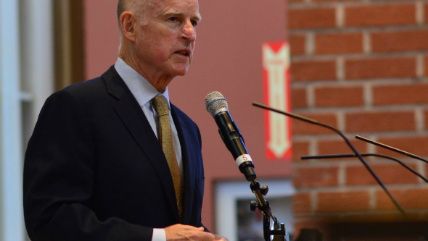California Uses One State Credit Card To Pay Off Another
Gov. Jerry Brown wants to borrow $6 billion to pay for California's underfunded public employee pensions.


California Gov. Jerry Brown has a plan to address his state's hundreds of billions of dollars in unfunded pension liabilities: Borrow money at low rates and invest it in a hopefully higher-yielding state pension fund.
Over the past two decades, several states and localities have borrowed to cover exploding pension liabilities. But the practice is fraught with risk, and it has backfired spectacularly on more than a few occasions. The City of Oakland, for instance, lost $250 million on a similar borrow-and-invest pension funding scheme when projected returns did not pan out. When New Jersey tried borrowing to cover pension obligations, it ended up being charged with securities fraud.
These risks do not seem to bother Brown, whose pension proposal—released as part of his "May Revision" budget—calls for borrowing $6 billion from a state savings account at 1.5 to 3.5 percent interest rates and investing that money in CalPERS, the state's pension investment fund, which Brown is counting on to make 7 percent returns.
If all goes according to the governor's plan, that $6 billion investment will be enough to save $11 billion in pension costs and pay back the state savings account. But that's a pretty big "if," especially given CalPERS' recent track record.
In 2014 CalPERS had a return target of 7.8 percent. Instead it brought in a measly 2.4 percent. That was bad, but at least it was better than 2015's .61 percent return. Last year saw a jump to 5.8 percent—better, but still far below what Brown needs.
Meanwhile, an economic downturn could wreak havoc with CalPERS' already depressed returns. Indeed, recessions are the main reason this approach to budgeting is so inherently risky.
A comprehensive study by Boston College's Center for Retirement Research found that states and localities that borrowed funds to cover pension obligations in the years leading up to an economic contraction overwhelmingly witnessed negative returns. CalPERS itself saw a negative 24 percent return on investment during the worst of the Great Recession.
Brown is clearly aware of this recessionary risk, saying as he announced his pension proposal that "an economic recovery won't last forever." So why is he pushing a proposal that depends on an ongoing economic recovery? The answer, according to that Boston College study, is necessity: Financial pressure, not fiscal wisdom, plays the biggest role in which states and localities go for this option. California currently faces a $5.8 billion budget shortfall, forcing the governor to scramble for any savings he can find.
Needless to say, that's not how the governor justified his move. He claims his proposal would "reduce unfunded liabilities and stabilize state contribution rates." A little context: California is looking at anywhere from $242 billion to $767 billion in unfunded pension liabilities. Even if Brown gets those $11 billion, the money will be a drop in the bucket compared to the tab coming due.
Rent Free is a weekly newsletter from Christian Britschgi on urbanism and the fight for less regulation, more housing, more property rights, and more freedom in America's cities.


Show Comments (59)